

A great mountaineering boot fills countless roles. It offers support while carrying heavy loads, grips confidently on slick rock and snow, and allows for the attachment of crampons and skis. After years of testing boots on some of the most demanding mountains in the world—from Chilean Patagonia to the rugged Himalayas—our overall favorite boot is the La Sportiva Nepal Cube GTX. We have other recommendations, too: extreme cold/high-altitude boots for the world’s tallest mountains, 4-season technical alpine boots for keeping your feet warm, and lightweight mountaineering boots for lower-elevation routes. For more background information, read our comparison table and buying advice below the picks, as well as a breakdown of how we approach the testing process.
Editor's note: We updated this guide on October 2, 2025, to remove the unavailable La Sportiva Trango Tech Leather GTX, add new photos from recent testing, and comb through the guide to ensure all information was current at the time of publishing.
.jpg) Category: 4-season technical alpine
Category: 4-season technical alpine
Body design: Single leather
Weight per pair: 3 lb. 15.0 oz. (men's), 3 lbs. 2.6 oz. (women's)
Crampon: Automatic
What we like: Versatile, comfortable, and lighter than competing models.
What we don’t: Leather absorbs water more readily than synthetic boots.
La Sportiva’s Nepal line has been the standard-bearer for technical single mountaineering boots for over two decades. There have been several iterations over the years, but the concept has stayed the same: a durable leather boot that excels across the spectrum of mountaineering. These boots have kept guides’ feet warm on Mount Rainer, are sufficient for all but the coldest days of kicking up dry ice in the Northeast, and should perform just fine on late April and May trips to the lower peaks in the Alaska Range. You can even bust out a few rock moves when needed, thanks to the rubber toe.
The Cube GTX retains the classic Nepal Evo’s technicality and jack-of-all-trades prowess, but with a few notable differences. For one, we love the addition of a removable tongue, which can be moved up or down (or taken out entirely) to add padding or make more space. Second, the Cube comes in at 8 ounces lighter for the pair than its predecessor, which results in a less durable sole and midsole, but is certainly an advantage during long slogs. If you're want to bump up a little in weight for added longevity, we'd instead recommend the Nepal Evo (4 lb. 7.4 oz.) or Scarpa Mont Blanc Pro GTX (3 lb. 15.5 oz.). Otherwise, the Nepal Cube GTX will give you the warmth and support you need in a premium, time-tested package.
See the Men's La Sportiva Nepal Cube See the Women's La Sportiva Nepal Cube

 Category: Lightweight mountaineering
Category: Lightweight mountaineering
Body design: Single synthetic
Weight per pair: 2 lb. 12.4 oz. (men's), 2 lbs. 2 oz. (women's)
Crampon: Semi-automatic
What we like: Lightweight and capable in a variety of terrain.
What we don’t: The sticky outsole lacks durability and will wear away quickly.
With advancements in gear, weather forecasting, and mountain access, the sport of mountaineering has been changing in recent years. Nothing reflects this more than La Sportiva’s Aequilibrium series, which comes in four versions: the synthetic ST, the leather LT, the premium Top, and the minimalist Speed. Many climbers will opt for the Aequilibrium ST GTX, which is most comparable to the Scarpa Charmoz HD (a boot that used to hold our top 3-season award). The ST is over half a pound lighter than the Charmoz; it's versatile on trail, snow, and rock; and it's both comfortable and durable. For Lower 48 missions that start in the trees and end on a snowy summit, it’s Sportiva’s best effort yet. This also doubles as our "best budget" award for its stellar versatility and value.
What do you give up with such a lightweight design? The Aequilibrium doesn’t offer much insulation, so we don’t recommend pushing it into particularly cold temperatures. What’s more, the sticky outsole rubber is a double-edged sword: It offers fantastic traction on rock, but the compound may wear away quickly if you wear it on more hard surfaces than snow. Gripes aside, after a thorough test of the Aequilibrium Top—which adds an integrated gaiter and Boa lacing system—we still think the Aequilibrium collection is about as good as it gets for a lightweight mountaineering boot.
Read more: La Sportiva Aequilibrium Top GTX (premium version of this boot)
See the Men's La Sportiva Aequilibrium ST See the Women's La Sportiva Aequilibrium ST
 Category: 4-season technical alpine
Category: 4-season technical alpine
Body design: Single synthetic w/gaiter
Weight per pair: 3 lb. 8.4 oz.
Crampon: Automatic
What we like: Great warmth-to-weight ratio, waterproof, highly technical.
What we don’t: Not warm enough for high-altitude endeavors.
Scarpa’s entire Phantom line looks so similar that it can be hard to tell the Tech apart from the 6000 and 8000, but the Tech HD is the racecar of the Phantom family and one of the most popular models for technical ice and mixed ascents. It’s lightweight, streamlined for precision, and warm for a single boot. You get PrimaLoft Gold and OrthoLite O-Therm insulation, Scarpa’s proprietary HDry waterproof membrane, and a durable Vibram sole that can hold its own on icy or rocky approaches. Rounding out the build is an integrated gaiter is secured by a watertight zipper along the side of the boot that doesn't interfere with the foot's flex, and a Recco reflector to aid in search efforts. Overall, the Phantom Tech HD is about as sleek as it gets among technical ice climbing designs, and it’s priced competitively.
The Phantom Tech HD is most similar to the La Sportiva's discontinued G5 Evo in terms of warmth, features, and design. Both offer a nice mix of precision and performance for steep ice and mixed ascents, but the Tech is the lighter of the two at about 4 ounces less for the pair. On top of that, the G5 did not have a waterproof zipper, which can make a big difference on approaches where you have to splash across creeks or on warm days when things get drippy. Sportiva's fancy G-Summit boot replaced the G5, though we haven't had an opportunity to test it yet (but will update our round-up as soon as we get the chance). All told, for a technical climbing boot that’s warm and durable but still responsive and precise, it’s hard to go wrong with the Phantom Tech HD.
See the Scarpa Phantom Tech HD
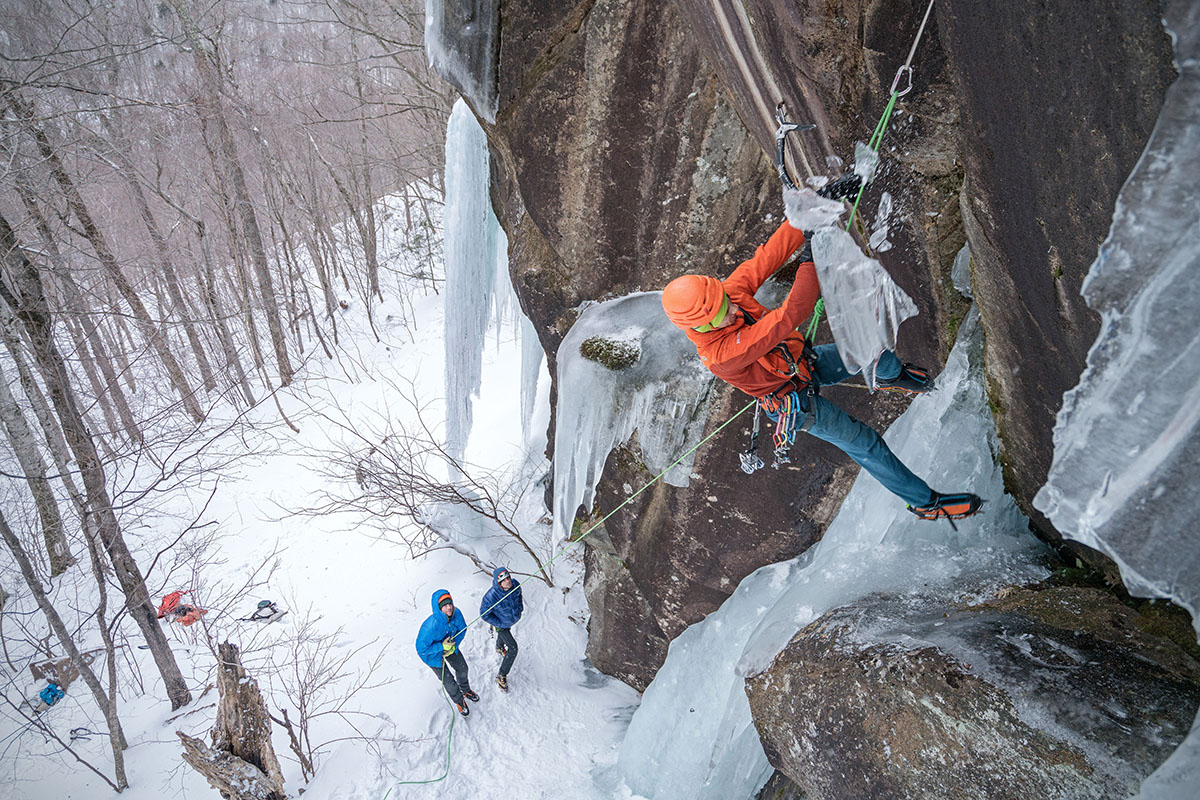
 Category: Extreme cold/high-altitude
Category: Extreme cold/high-altitude
Body design: Double synthetic
Weight per pair: 4 lb. 10.0 oz.
Crampon: Automatic
What we like: A premium and time-tested high-altitude boot that is like an oven for your feet.
What we don’t: Pricey.
The La Sportiva Olympus Mons Cube is perhaps the most popular double boot on the market for extreme cold. It’s the go-to model for mountaineers looking to stay warm in extreme places like Denali’s West Buttress, Mount Everest, and Antarctica’s Mount Vinson. The uber-comfortable, heat-moldable inner boot accommodates a wide range of foot sizes, and the outer boot’s dual Boa closures (which tighten the lower and upper halves separately) can be adjusted with one hand and don’t require any tying (perfect when you’re wearing bulky gloves or mittens). On top of it all, a durable, wraparound zipper and Velcro strap seal off your feet from the frozen elements of the world’s biggest mountains.
Past versions of the Oly Mons were plagued by reports of the outsole wearing out quickly, but the “Cube” update addressed this with a more durable Vibram Litebase compound. Many will also appreciate the tech inserts at the toe, which eliminate the need for ski boots when approaching your objective on skis (alternatively, the “Cube S” version has a standard toe). The Oly Mons Cube will indeed cost you at $1,299, but for a bombproof boot made to withstand the worst weather on earth, you probably won’t regret the investment.
See the La Sportiva Olympus Mons Cube
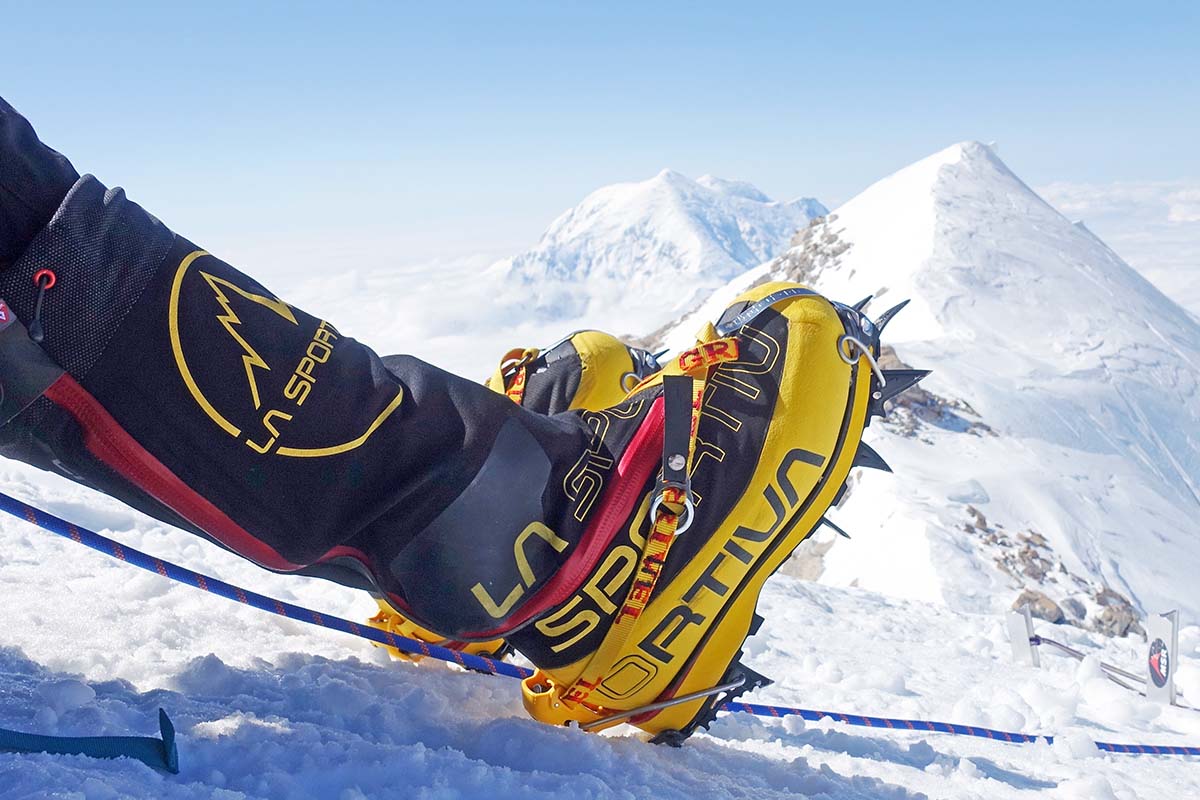
 Category: 4-season technical alpine
Category: 4-season technical alpine
Body design: Double synthetic
Weight per pair: 4 lb. 10.0 oz.
Crampon: Automatic
What we like: Great warmth for the weight and easy-to-adjust Boa lacing system.
What we don’t: High-volume fit.
The original G2 was a radical shift in La Sportiva’s double-boot lineup, shaving 8 ounces per boot from the technically charged Spantik. And with insulation almost on par with the Everest-ready Olympus Mons Cube, it certainly doesn’t make any compromises in terms of warmth either. In addition to the G2’s impressive specs, you also get a dual Boa lacing system for quick adjustments that eliminate the need to tie laces in the extreme cold, and the built-in super gaiter keeps your inner boot dry and toasty. It all adds up to a warm, lightweight, and easy-to-operate boot, ideal for those with their sights set on 5,000- to 7,000-meter peaks in the greater ranges.
The G2 was semi-recently updated to the G2 Evo, with a few revisions to the outer boot’s materials and design. In addition to a more durable and water-repellent upper, Sportiva moved the top Boa dial from the inner boot to the outside, which is a big improvement for on-the-go adjustments. Compared to the Scarpa Phantom 6000, the G2 Evo is the same weight for less cash, and some will appreciate the Boa closure (while others remain dubious about their durability). We recently took the G2 Evos on a mountaineering trip to Nepal, where they kept us cozy at elevations up to 6,189 meters with sub-zero temperatures. The fit was stellar, and we walked out of the mountains with zero blisters—or even hotspots—to speak of. It's worth noting that some report the G2 Evo has a fairly high-volume fit. We found it fit wider than other Sportiva boots in our closet (which generally run pretty narrow), but the extra wiggle room was just about perfect for our needs—and great for accommodating chunky alpaca wool socks.
See the La Sportiva G2 Evo
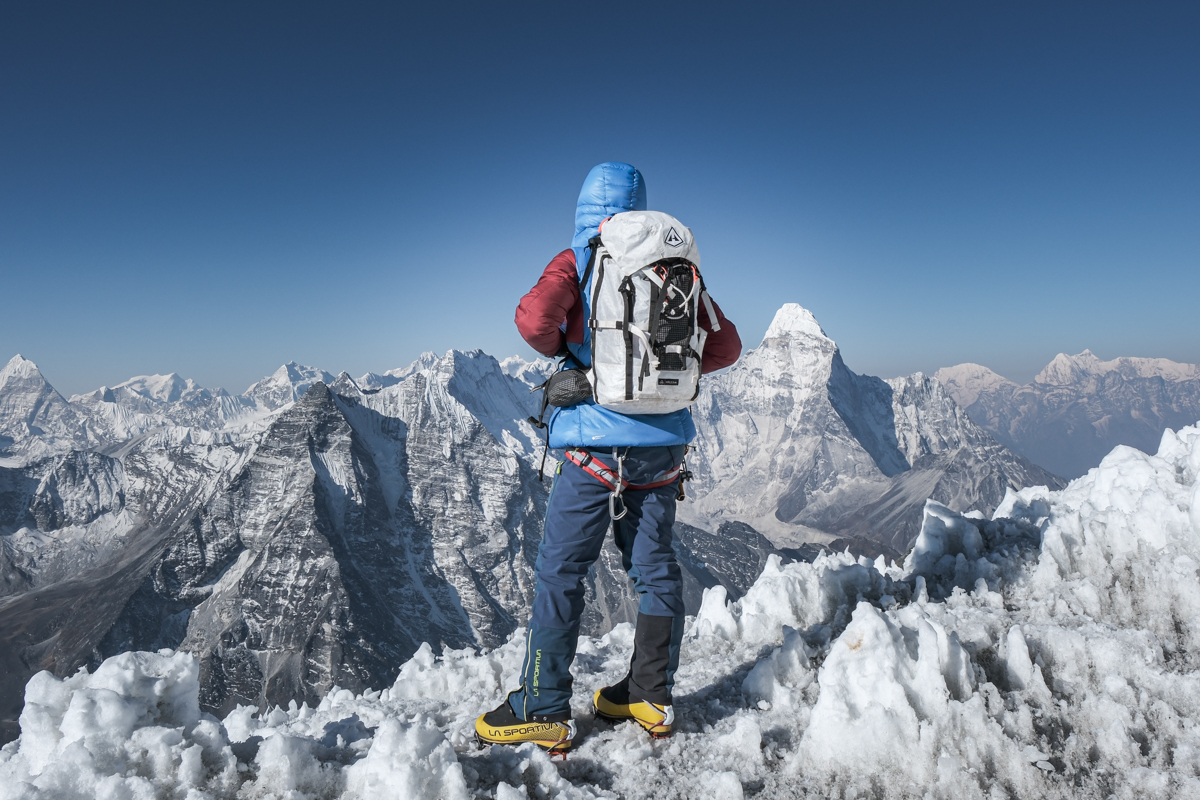
 Category: Lightweight mountaineering
Category: Lightweight mountaineering
Body design: Single synthetic
Weight per pair: 3 lb. 6.4 oz. (men's), 2 lbs. 12 oz. (women's)
Crampon: Semi-automatic
What we like: A time-tested 3-season mountaineering boot.
What we don’t: A half-pound heavier than the Aequilibrium ST above.
Along with the La Sportiva Aequilibrium ST above, the Scarpa Charmoz HD is a great option when you need one piece of footwear to get you from the car to the summit. From long approaches through treeline to crossing glacier-polished granite slabs and cramponing up icy summit pyramids, the Charmoz will keep your feet dry and agile. It is decidedly a 3-season boot—the light insulation, quasi-flexible sole, and high rocker mean that the Charmoz is not an ideal choice for technical ice climbing or mountaineering in cold conditions. But for spring-to-fall weekend missions into the Cascades, Bugaboos, Rockies, or Sierra, it is an excellent choice.
On the flip side, the Charmoz HD used to be one of the lightest options here, but the Aequilibrium ST above is 10 ounces lighter and proves you can drop considerable weight without compromising performance. What's more, the $50-cheaper Aequilibrium tacks on premium Gore-Tex waterproofing, while the Charmoz sticks to Scarpa’s in-house HDry. That said, it is worth noting that the Scarpa’s durability is proven—mountaineers have trusted the Charmoz for years now—while the La Sportiva's sole is known to degrade all too quickly when used on rock and other hard surfaces. If covering miles and vertical versatility are what you are looking for, the Charmoz HD is a nice synthetic boot with a great track record.
See the Men's Scarpa Charmoz HD See the Women's Scarpa Charmoz HD
 Category: 4-season technical alpine
Category: 4-season technical alpine
Body design: Single leather
Weight per pair: 3 lb. 15.5 oz. (men's), 3 lbs. 7 oz. (women's)
Crampon: Automatic
What we like: Cheaper and more performance-oriented than the La Sportiva Nepal Cube GTX.
What we don’t: The fit may be too wide for some.
If you’re in the market for a jack-of-all-trades mountaineering boot, it’s a tough call between our top-ranked Nepal Cube GTX and Scarpa’s Mont Blanc Pro GTX. Both boots are ideal quiver-of-one options for low-altitude mountaineering and technical winter climbing: they walk well, climb ice confidently, and are warm enough to trust for all-season endeavors. We recently tested the Mont Blancs on an ice climbing trip in Colorado, and came away incredibly impressed. While we still feel like Scarpa's Phantom Tech HD above deserves the Best for Technical Ice Climbing award, this is a stellar option for milder conditions at a better price, though they are heavier. Their single leather upper designs are durable without adding too much bulk, and welts on the toe and heel offer secure automatic crampon attachment—unlike a boot like the Scarpa Charmoz above.
The main distinctions between this and the Charmoz come in price, fit, and technical performance. Furthermore, in the latest update, Scarpa added a more precise outsole for better climbability on particularly technical snow and ice. And for a lower price than the Cube, the Mont Blanc Pro gets the price advantage as well. Some find the Nepal Cube GTX to be a warmer boot, but we haven’t noticed a difference. If you’re still torn between the two, we’d recommend making a decision based on fit: as with most of their boots, the Scarpa will have a wider fit and the La Sportiva a bit narrower.
See the Men's Scarpa Mont Blanc See the Women's Scarpa Mont Blanc
 Category: 4-season technical alpine
Category: 4-season technical alpine
Body design: Double synthetic
Weight per pair: 4 lb. 10.0 oz.
Crampon: Automatic
What we like: Simple but effective lacing system, watertight zipper, technical fit.
What we don’t: Pricier than the La Sportiva G2 Evo; difficult to get your hands on a pair.
Of all the technical double boots on this list, the Scarpa Phantom 6000 HD offers some of the best performance, construction, and overall feel. This is Scarpa’s go-to model for giant ice routes in the Canadian Rockies and technical Alaskan ascents, and we feel confident in saying that it’s also a great option for many mid-season Denali climbers (Scarpa’s Phantom 8000 Thermic is even warmer but significantly heavier). And at only 4 pounds 10 ounces for the pair (size 42), the Phantom 6000 HD is one of the lightest in its class, right alongside the premium La Sportiva G2 Evo above. In terms of construction, a PrimaLoft Black and Gold Eco insulated liner provides ample padding and warmth, and the OrthoLite/Aerogel insole is a great defense against cold ground. On the outside, burly Schoeller fabric offers bombproof protection for your foot from weather and sharp objects alike.
The wraparound zipper concept can feel weird at first, but we appreciate the fact that this design almost entirely protects the zipper from being scuffed by the passing point of a crampon—though we personally prefer the Boa system used in the G2 Evo. Finally, with the most recent update, the Phantom 6000 is now made with more environmentally friendly materials, so you can explore your home planet with a bit less impact. This is a prime contender for the best boot for 5,000- to 7,000-meter peaks, but we give the edge to the G2 Evo due to its dual Boa lacing system (which, admittedly, isn't for everyone), cheaper price, and greater availability. As such a popular model, the Phantom 6000 HD is often extremely difficult to find with limited stock at many vendors (including Backcountry at the time of publishing). This stands out as our biggest gripe. We recently tried for a couple of months to snag a pair in our size for a trip to the Himalayas with no luck. If you can get your hands on them, though, these are downright difficult to beat.
See the Scarpa Phantom 6000 HD
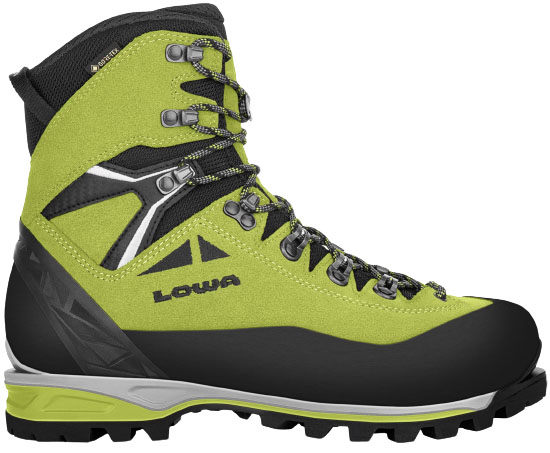 Category: Lightweight mountaineering/4-season technical alpine
Category: Lightweight mountaineering/4-season technical alpine
Body design: Single leather
Weight per pair: 3 lb. 6.7 oz. (men's), 3 lbs. 3.5 oz. (women's)
Crampon: Automatic
What we like: A versatile and durable boot for everything from basic mountaineering to technical climbing.
What we don’t: Not as stiff as a dedicated ice climbing boot; heavy for a lightweight mountaineering boot.
The Lowa Alpine Expert II GTX is an incredibly versatile option, falling somewhere in between our lightweight mountaineering and 4-season technical alpine categories. As a result, it’s a reliable choice for a wide range of activities and a great quiver-of-one option for those looking to save money. With a relatively lightweight build, the Lowa gets the job done on the trail, but automatic crampon compatibility and ample stiffness underfoot mean it can also tackle steep ice and precise footwork on hairy mixed leads. Tack on a burly leather upper and 400-gram PrimaLoft insulation, and you have a warm single boot that’s hard to kill.
Keep in mind that with the Alpine Expert’s jack-of-all-trades design, it verges on being master of none. You don’t get quite as much warmth and stiffness as a dedicated 4-season boot like the Nepal Cube or Mont Blanc Pro. At the other end of the spectrum, it features slightly less rocker than most lightweight mountaineering boots, which can get in the way of comfort on the approach—although the most recent design does boost flex at the ankle. And while it’s one of the most affordable options among boots that feature a toe welt, you can save even more with a model like the La Sportiva Makalu (below). All gripes aside, for a durable and versatile boot that can handle most everything you throw at it, the Alpine Expert GTX II is one of the best values on this list.
See the Mens's Lowa Alpine Expert II GTX See the Women's Lowa Alpine Expert II GTX
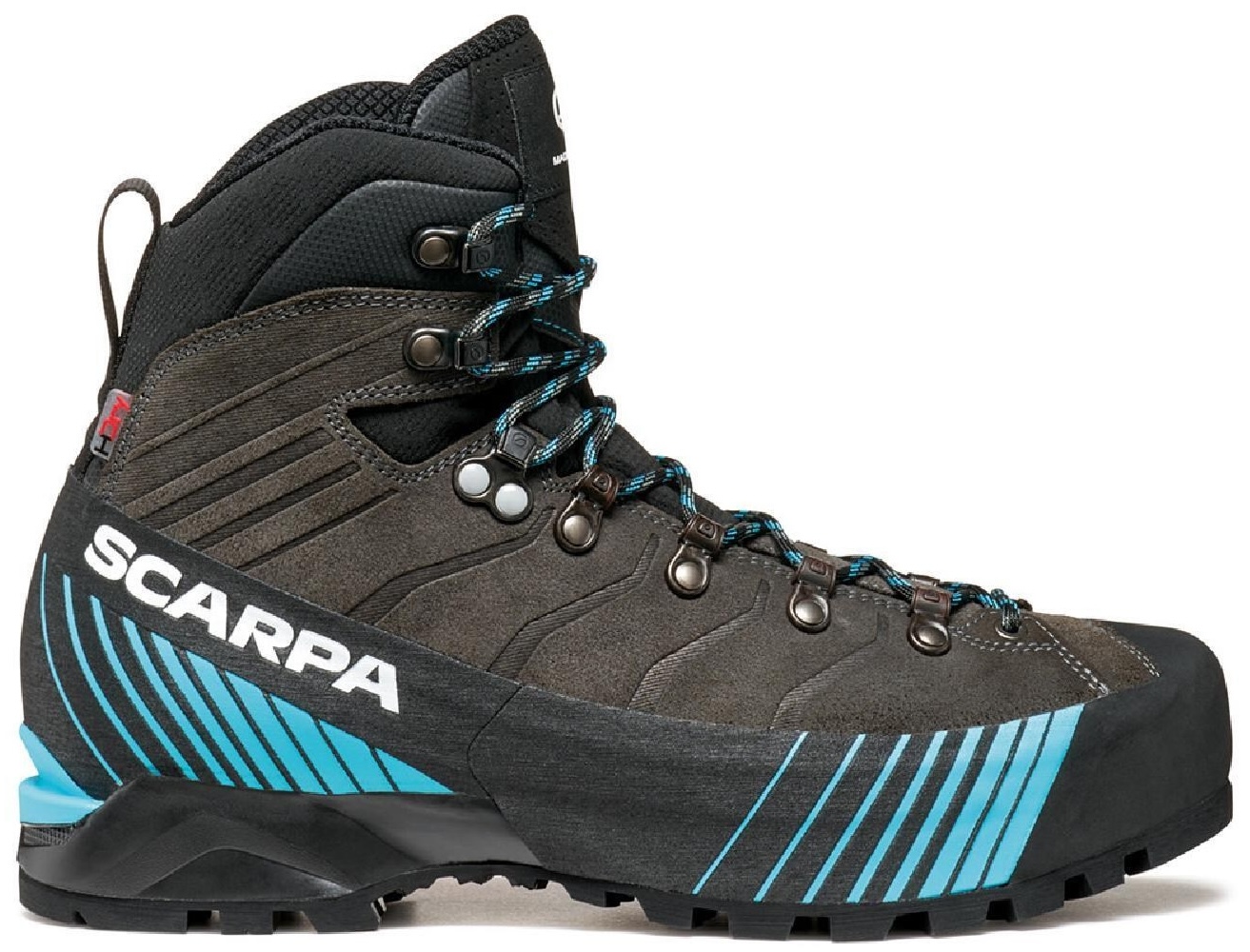 Category: Lightweight mountaineering
Category: Lightweight mountaineering
Body design: Single leather
Weight per pair: 3 lb. 1.0 oz.
Crampon: Semi-automatic
What we like: A sturdy mountaineering boot that’s still comfortable on the trail.
What we don’t: Not super waterproof; fairly expensive.
In 2025, it feels like everyone wants to move a bit faster, whether you’re mountain running, climbing, or mountaineering. Answering the call for mountaineers is the Scarpa Ribelle HD, a design that offers the stable platform of a leather mountain boot alongside the easy-moving feel of a running shoe. Scarpa accomplishes this wild combination through their Dynamic Tech Roll System, a fancy name for a rockered sole that helps you efficiently spring off the ball of your foot. We were at first skeptical of the Ribelle HD, but all signs point to it being a comfortable and relatively uncompromised boot for 3-season mountaineering and backpacking alike.
The Ribelle HD is a great boot for objectives that contain equal parts trail, rock, and snow (and even ice), but we don’t recommend it for routes predominantly made up of snow (such as PNW volcanoes). Scarpa’s HDry membrane can’t compete with more premium Gore-Tex, and the suede upper will absorb water unless treated with a repellent or seal. What’s more, you simply don’t need the running-shoe-inspired rocker on snow—to reap the most benefits from the Ribelle’s design, you’ll want to be spending a considerable amount of time on trail. And a final note: The Ribelle HD has a fairly roomy toe box, which is great news for those with wide or finicky feet. If you want to go even lighter, Scarpa also offers the Ribelle Lite HD, which drops about 1.5 ounces off each boot with a lighter and more flexible upper.
See the Men's Scarpa Ribelle HD See the Women's Scarpa Ribelle HD
 Category: Extreme cold/high-altitude
Category: Extreme cold/high-altitude
Body design: Double synthetic
Weight per pair: 6 lb. 6.2 oz.
Crampon: Automatic
What we like: Groundbreaking removable heated insoles; great quality and warmth.
What we don’t: Heavier than the Olympus Mons above; very expensive.
The Phantom 8000 Thermic HD is the durable workhorse for extreme cold in Scarpa’s line. It's also the most technologically complex—and pricey—option on this list. From the ground up, Scarpa designed a serious boot here, and a recent upgrade adds some space-age tech that's sure to keep you cozy at the highest altitudes on Earth. In addition to top-tier insulation and layers of warmth, Scarpa added a removable, heated insole complete with an external power switch and two power banks (5,000mAh and 10,000mAh), which can be routed to the pair of heated footbeds. These aren't your average climbing boots. You also get a waterproof PrimaLoft Gold 200-lined gaiter as the first line of defense, while a WinTherm and PrimaLoft Gold Eco-insulated liner with a simple pull-down speed lace keeps your foot tight and toasty. All in, these kicks boast a staggering 18 total layers of technology to deliver perhaps the most premium warmth you could find.
If you’re looking for the best high-altitude mountaineering boot, it’s a close call between the Scarpa Phantom 8000 Thermic and the La Sportiva Olympus Mons Cube above. Both boots are extremely warm and well-made with keen attention to detail. But the Phantom 8000 Thermic is almost 2 pounds heavier for the pair (which is significant) and wildly more expensive at $1,799. We much prefer the dual Boa closure on the Oly Mons (we’ve experienced slipping with Scarpa’s lacing system), and La Sportiva’s new tech binding compatibility could tip the scales for some. The complex battery-powered heating system of the Scarpa adds weight and bulk, though this might be worth it for the intrepid mountaineer braving the coldest temps imaginable. In the end, you can’t go wrong with either boot, and your final decision likely will come down to fit and the particular expedition you have in your crosshairs. Note: We have yet to test the Phantom 8000 Thermic, but have plenty of experience with the previous Phantom 8000. We can't authoritatively say that the Thermic holds up to the same standards, but we have yet to hear otherwise and will update this review once we have some experience with the latest design.
See the Scarpa Phantom 8000 Thermic HD
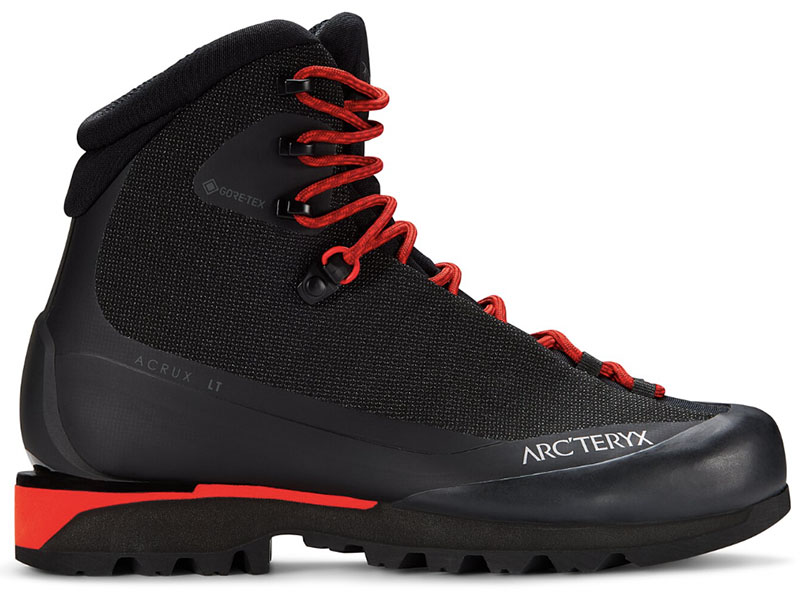 Category: Lightweight mountaineering
Category: Lightweight mountaineering
Body design: Single synthetic
Weight per pair: 2 lb. 14.0 oz.
Crampon: Semi-automatic
What we like: Premium build quality and great precision and stability on rock and snow; sleek, streamlined look and design.
What we don’t: Runs narrow; stiff design isn’t particularly comfortable for trail walking; pricey.
We’ve learned to trust Arc’teryx for their top-shelf hardshell jackets, but we were admittedly a bit dubious when they started making footwear. The now-discontinued Acrux AR well exceeded our expectations with its innovative design, proving that the BC-based company can indeed make a solid boot. Building off the AR’s success is the LT, a single boot that’s primed for most mountain climbing in the Lower 48. Notably, its low-profile design offers great precision for scrambling on rock, and the stiff carbon-plated sole gives you a lot of assurance on snow, with or without a crampon. And with a strong SuperFabric upper and the exceptional workmanship we’ve come to expect from Arc’teryx, the LT is incredibly durable for its weight.
The Acrux LT joins the ranks of models like the Aequilibrium ST and Charmoz HD above as one of the best lightweight mountaineering boots in the game. But at $500, it's a good bit pricer than the La Sportiva (and was recently bumped up from $400) and falls between the two designs in terms of weight. Keep in mind that the stiff build that makes the Acrux so stable on rock and snow doesn’t provide a ton of cushion or rocker—designs like the Aequilibrium and Ribelle above offer a plusher feel for those who spend a lot of time on trail. It’s also worth noting that Arc’teryx footwear has a tendency to run quite narrow, and the Acrux LT is only offered in unisex sizes. But for a stiff, stable, and lightweight mountaineering boot, this is a great option for the right adventurer. It is also one of the most sleek, stylish-looking mountaineering boots out there—if that's your jam.
See the Arc'teryx Acrux LT GTX
 Category: Lightweight mountaineering
Category: Lightweight mountaineering
Body design: Single leather
Weight per pair: 3 lb. 1.4 oz. (men's), 2 lb. 8.2 oz. (women's)
Crampon: Semi-automatic
What we like: Very durable compared to others in its class.
What we don’t: Despite the lightweight build, it still feels stiff and unpadded on the trail; limited stock.
Scarpa’s Zodiac Tech GTX is a stripped-down design that hits a nice middle ground between a mountaineering boot and an approach shoe. Its intentions are very similar, with a sticky Vibram Mulaz Z outsole, a heel welt for semi-automatic crampon compatibility, and a proven Gore-Tex membrane for water protection.
In trying both boots on, there are some clear fit-related nuances to be aware of. In particular, the Trango Tech has a narrower profile that feels slightly more technical, while those with wider feet will appreciate the Zodiac Tech’s roomier build. Importantly, both are stiffer and noticeably less cushioned than your standard hiking boot (again, more along the lines of an approach shoe), which could be a deterrent depending on your objectives and what you’re used to. If you’re looking for more comfort for covering a lot of miles on the trail, check out Scarpa’s Ribelle HD.
Read more: Scarpa Zodiac Tech review (men's version)
See the Men's Scarpa Zodiac Tech GTX See the Women's Scarpa Zodiac Tech GTX
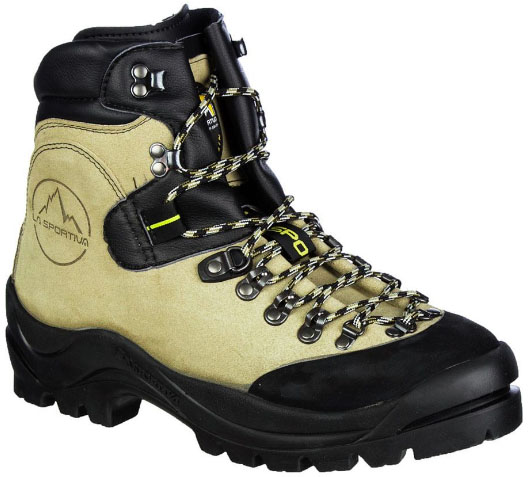 Category: Lightweight mountaineering
Category: Lightweight mountaineering
Body design: Single leather
Weight per pair: 4 lb. 5.1 oz.
Crampon: Automatic
What we like: Classic design for general mountaineering, no frills, extremely durable, and cheap.
What we don’t: Limited to basic mountaineering and heavier than similar boots.
The La Sportiva Makalu is the essence of a traditional mountaineering boot: it’s burly, supportive, and extremely durable. Neither flashy nor technical, this classic leather design works well for basic mountaineering and possibly as your first real boot. For example, the Makalu is a favorite for National Outdoor Leadership School students since it serves the needs of heavy backpacking and light mountaineering equally. It can trek the length of the Pacific Crest Trail and climb Mount Hood or Mount Saint Helens along the way.
Like the La Sportiva Aequilibrium ST GTX above, the Makalu is not meant for serious cold-weather mountaineering. With a traditional leather upper, it also forgoes high-tech synthetic materials and a waterproof Gore-Tex membrane. But the Makalu is built to withstand years of abuse on scree slopes and in alpine environments. A Vibram toecap protects the front of the boot when kicking up rocky flanks, and the full-shank sole affords the use of automatic crampons (for semi-automatic crampon compatibility, check out La Sportiva's similar Karakorum). At $379, the Makalu still offers an impressive all-around feature set and will last longer than lighter and more modern competitors like the Aequilibrium ST. You won’t be pushing the limits of technical climbing in the Makalu, but that isn’t its purpose.
See the La Sportiva Makalu
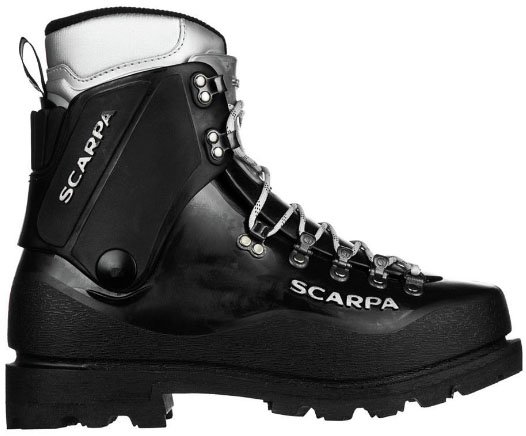 Category: 4-season technical alpine
Category: 4-season technical alpine
Body design: Double synthetic
Weight per pair: 5 lb. 8.0 oz.
Crampon: Automatic
What we like: Well-priced, nearly indestructible, and time-tested in cold environments.
What we don’t: Clunky and less precise than the modern double boots above; stock liner takes a long time to dry.
If the Scarpa Phantom Tech is the race car of mountaineering boots, the Inverno is the tank. Plastic double boots have largely fallen out of favor over the last five years, but you can’t beat them for durability—your feet will wear out before the boot does. The Inverno is far less technical in nature than an option like the G2 Evo or Phantom series, but it will outlast them all. That, and there’s little chance the plastic shell will let moisture seep in.
If you plan to use this boot for a cold-weather mountain like Denali, we highly recommend that you splurge for a warmer and lighter Intuition liner. This is best done at a specialized mountaineering shop, but many shops will only custom-fit boots that are purchased at their store. We also recommended you add a Forty Below Purple Haze neoprene overboot if climbing a cold mountain like Denali. When these two aftermarket features are added, the cost-benefit analysis between this system and a discounted double boot becomes a little less discernible. Regardless, if you aren’t planning on spending much time at freezing altitude or are on a tight budget, the Inverno may be the boot for you.
See the Scarpa Inverno
| Boot | Price | Category | Design | Weight | Crampon |
|---|---|---|---|---|---|
| La Sportiva Nepal Cube GTX | $699 | 4-season technical alpine | Single leather | 3 lb. 15.0 oz. | Automatic |
| La Sportiva Aequilibrium ST | $379 | Lightweight mountaineering | Single synthetic | 2 lb. 12.4 oz. | Semi-auto |
| Scarpa Phantom Tech HD | $899 | 4-season technical alpine | Single synthetic | 3 lb. 8.4 oz. | Automatic |
| La Sportiva Olympus Mons Cube | $1299 | Extreme cold/high-altitude | Double synthetic | 4 lb. 10.0 oz. | Automatic |
| La Sportiva G2 Evo | $1,099 | 4-season technical alpine | Double synthetic | 4 lb. 10.0 oz. | Automatic |
| Scarpa Charmoz HD | $399 | Lightweight mountaineering | Single synthetic | 3 lb. 6.4 oz. | Semi-auto |
| Scarpa Mont Blanc Pro | $649 | 4-season technical alpine | Single leather | 3 lb. 15.5 oz. | Automatic |
| Scarpa Phantom 6000 HD | $1,299 | 4-season technical alpine | Double synthetic | 4 lb. 10.0 oz. | Automatic |
| Lowa Alpine Expert II GTX | $500 | Lightweight/4-season | Single leather | 3 lb. 6.7 oz. | Automatic |
| Scarpa Ribelle HD | $419 | Lightweight mountaineering | Single leather | 3 lb. 1.0 oz. | Semi-auto |
| Scarpa Phantom 8000 Thermic | $1799 | Extreme cold/high-altitude | Double synthetic | 6 lb. 6.2 oz. | Automatic |
| Arc’teryx Acrux LT GTX | $500 | Lightweight mountaineering | Single synthetic | 2 lb. 14.0 oz. | Semi-auto |
| Scarpa Zodiac Tech GTX | $399 | Lightweight mountaineering | Single leather | 3 lb. 1.4 oz. | Semi-auto |
| La Sportiva Makalu | $379 | Lightweight mountaineering | Single leather | 4 lb. 5.1 oz. | Automatic |
| Scarpa Inverno | $459 | 4-season technical alpine | Double synthetic | 5 lb. 8.0 oz. | Automatic |
You can't just hop out on your local trail to casually test a pair of mountaineering boots. Well... that's not entirely true. One of our authors spent hours slogging up and down a humid Appalachian slope, accruing a puddle of sweat in the G2 Evos to gauge their fit. But, in general, this category requires seriously getting after it on far-flung peaks to truly test the mettle of these hardy, high-altitude kicks. Which is just what we've done. With an impressive resume of gnarly alpine ascents all over the world, former Senior Editor Jenny Abegg wrangled together our initial selection of 18 diverse models back in 2018. No stone was left unturned in an effort to narrow in on the crème de la crème of these brawny boots, and the team has kept their finger on the pulse ever since to ensure this roundup stays current and relevant.
Senior Editor Chris Carter inherited the guide in early 2024. An avid big wall, trad, and sport climber, Chris has been slowly breaking into the mountaineering scene after discovering the joy of sipping air through a straw and forgetting what his feet feel like. From lofty peaks in East Africa to the towering giants of the Himalayas, he's spent countless days waiting out storms in base camp and crawling over icy knife edges to fist-bump his partners. He is constantly scouring the web, bugging the pros, and trudging around in different boots to make sure we cover the most deserving designs out there. The above selection of 15 models represents years of research and dedicated testing, and we feel confident recommending any of them for your mountaineering endeavors.
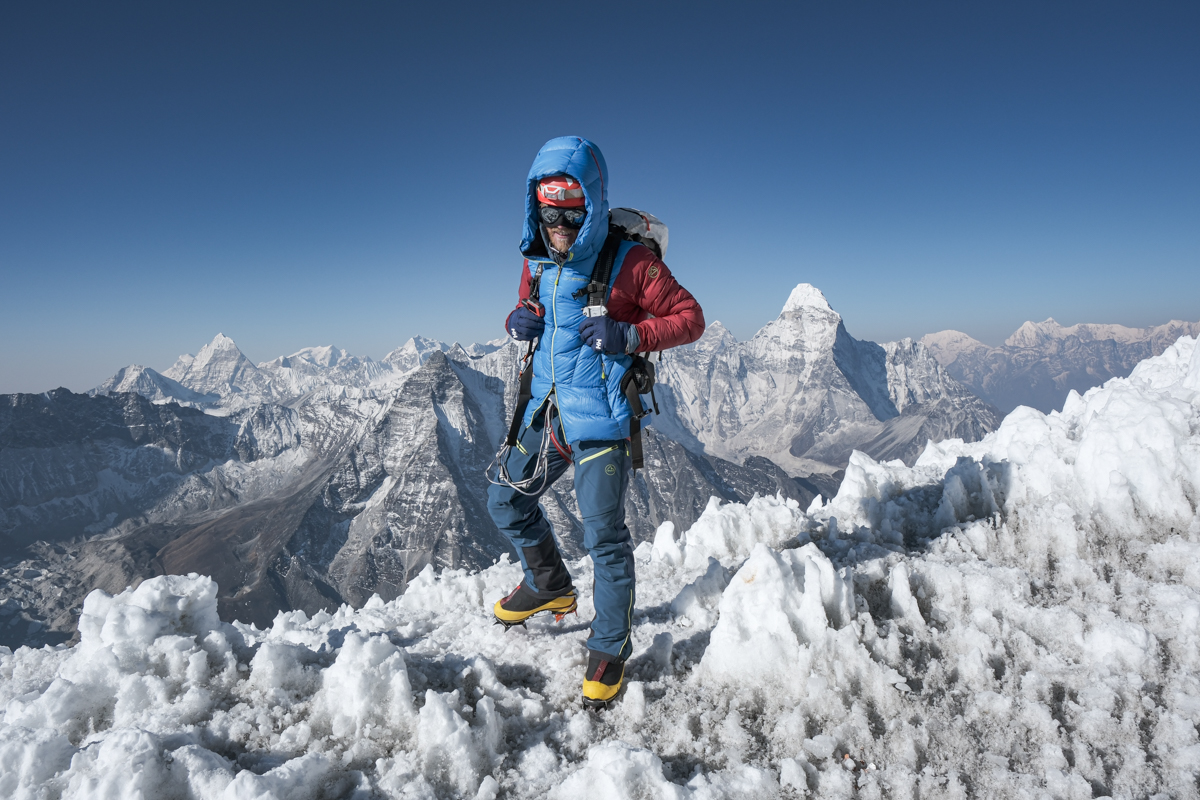
Extreme Cold/High-Altitude
Mountains come in all shapes, sizes, and levels of technical difficulty, so it’s imperative that your footwear is best suited for the conditions you will be encountering. For the highest and coldest mountains in the world—7,000 and 8,000-meter Himalayan peaks, Denali, and Antarctica—warmth is the utmost consideration. Extreme cold/high-altitude boots are heavy, warm, and commonly take the form of double or even triple boots (with a shell, liner, and fixed gaiter). Combining high-quality construction with some of the most bombproof materials in outdoor gear, boots in this category (like the La Sportiva Olympus Mons Cube) are all incredibly impressive, and your final decision will likely come down to one of fit.
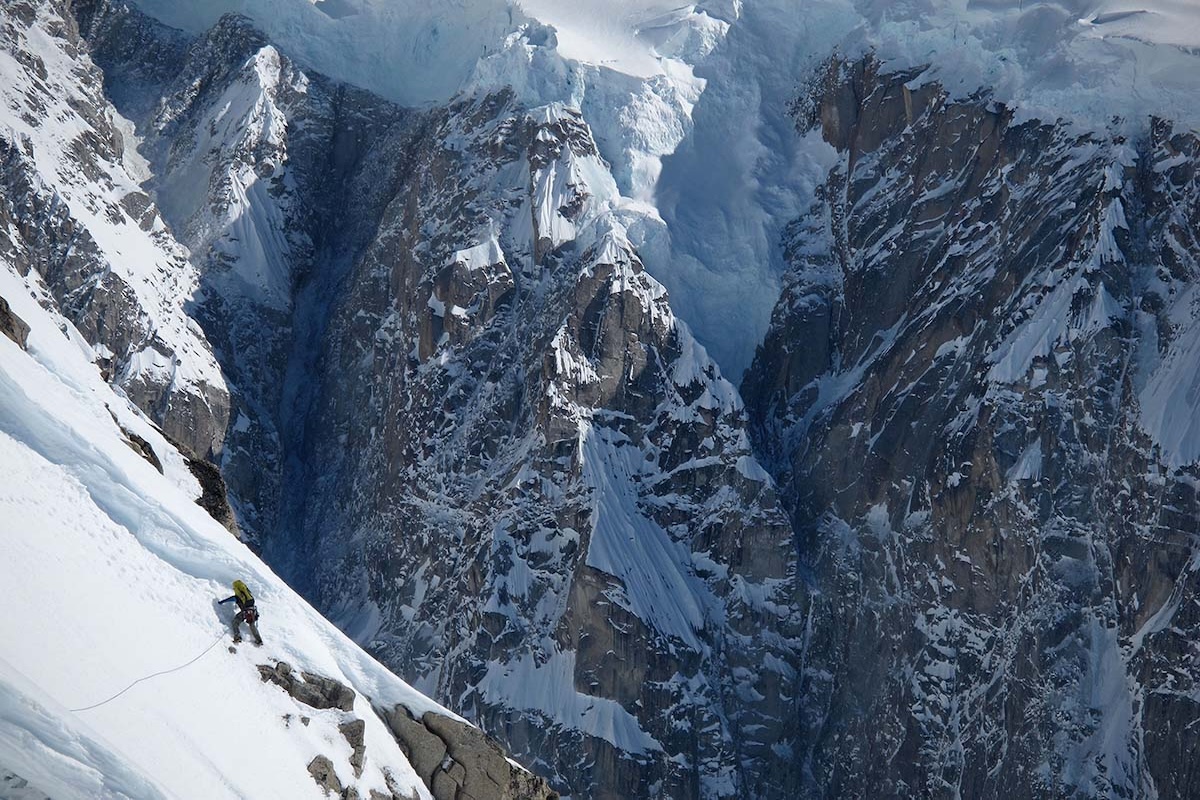
You'll want to make sure that your expedition actually merits the use of boots in this category, because they don't come without a significant cost. First, you probably won't be wearing these until the crampon point of your climbs, which could mean hauling them for long distances on either the outside or inside of your backpack. Running from nearly 5 pounds to well over 6 (Scarpa's Phantom 8000 Thermic HD packs a hefty punch), these aren't the most fun to tote up a mountain—in addition to all the other clunky gear these climbs demand. It's a good idea to have logged a few training hikes with these boots strapped to your back so you feel comfortable with the weight and bulk before embarking on your journey.
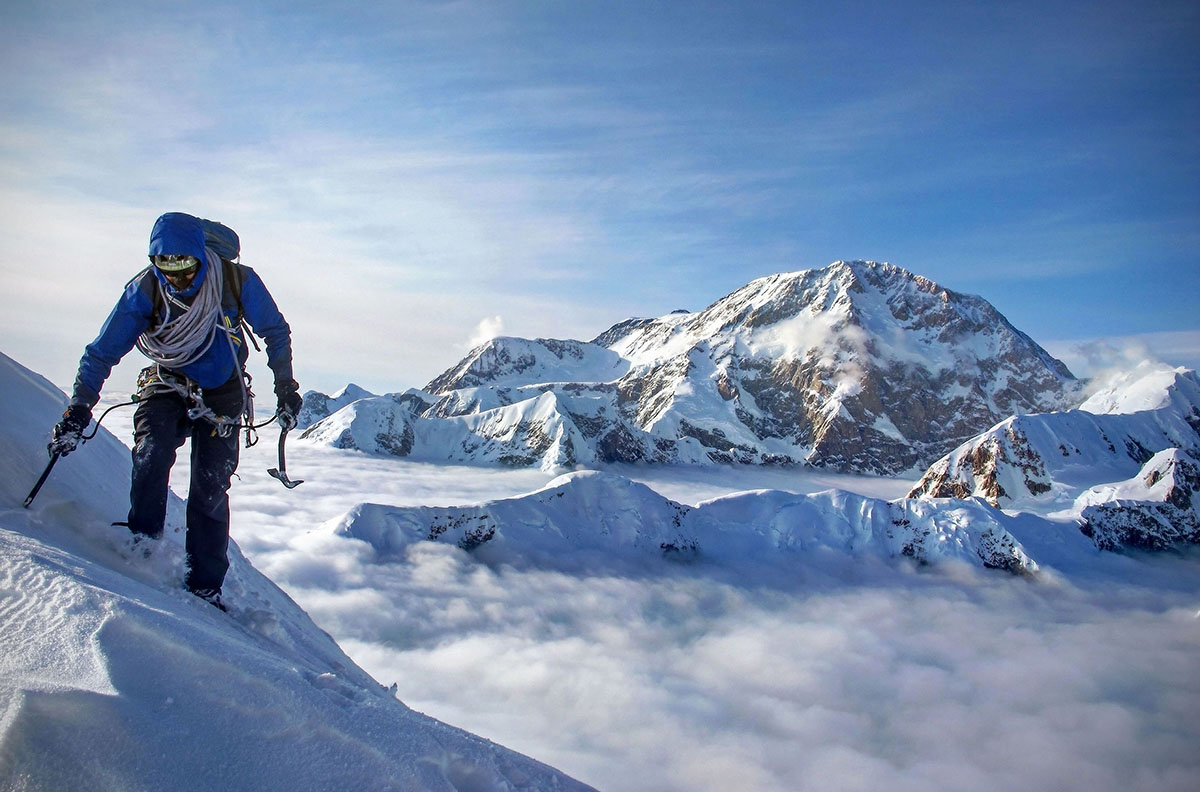
4-Season Technical Alpine
For giant ice routes in the Canadian Rockies, alpine-style ascents of lower mountains in the Alaska Range, and even mid-season climbs of Denali, a 4-season technical alpine boot may be your best bet. These boots come in double and single varieties and are made for both walking and technical ice climbing (some excel at one better than the other), with the commonality being that they sacrifice the highest levels of warmth for technical prowess (they can handle the cold, just not extreme cold). Leading models in this category include the Scarpa Phantom 6000 HD and La Sportiva G2 Evo. These will keep you cozy up to altitudes near 7,000 meters in the right conditions and are perfect for the more approachable 5,000- to 6,000-meter peaks in greater ranges like the Himalayas, where true 8,000-meter boots would simply be overkill.

Lightweight Mountaineering
For lower-elevation climbs and more moderate temperatures, lightweight boots should do the trick. These boots are a technical step up in construction from a hiking boot and built to handle long approaches. Lightweight single boots are commonly used for trips such as Cascade peaks and volcanoes or a car-to-summit adventure starting below treeline and ending with basic to moderate mountaineering. Most are 3-season boots with light insulation, a quasi-flexible sole, and high rocker, which means that they are not an ideal choice for technical ice climbing or frigid conditions. Popular lightweight mountaineering boots include models like those from La Sportiva's Aequilibrium series (including the ST, LT, Top, and Speed) and Scarpa Charmoz HD.

Nothing is more frustrating or potentially dangerous than cold feet, and toes can go from cold to numb to frostbitten in a matter of minutes. That is why it’s imperative to have the proper boot design for your objective. Single boots lack a removable liner and, therefore, are the lightest and least warm type of mountaineering footwear. Double boots, on the other hand, have more insulation along with a removable liner, making them warmer and better suited for multi-day trips. The ability to remove the liner and dry it out at night is imperative on big mountains—nothing is worse than shoving your feet into frozen boots in the frigid, pre-dawn darkness of an alpine start.
For spring and summer ascents in lower altitude ranges like the Cascades or Canadian Rockies, a single boot should provide enough warmth. It will be light enough to wear on a lengthy approach but offer enough support to keep your feet comfortable under the weight of a heavy pack. Single boots almost always have more of a next-to-skin feel, meaning they feel more technical and lower profile than their double-walled brethren. La Sportiva's Aequilibrium ST GTX stands out as perhaps our favorite lightweight single boot for a wide variety of tamer objectives.
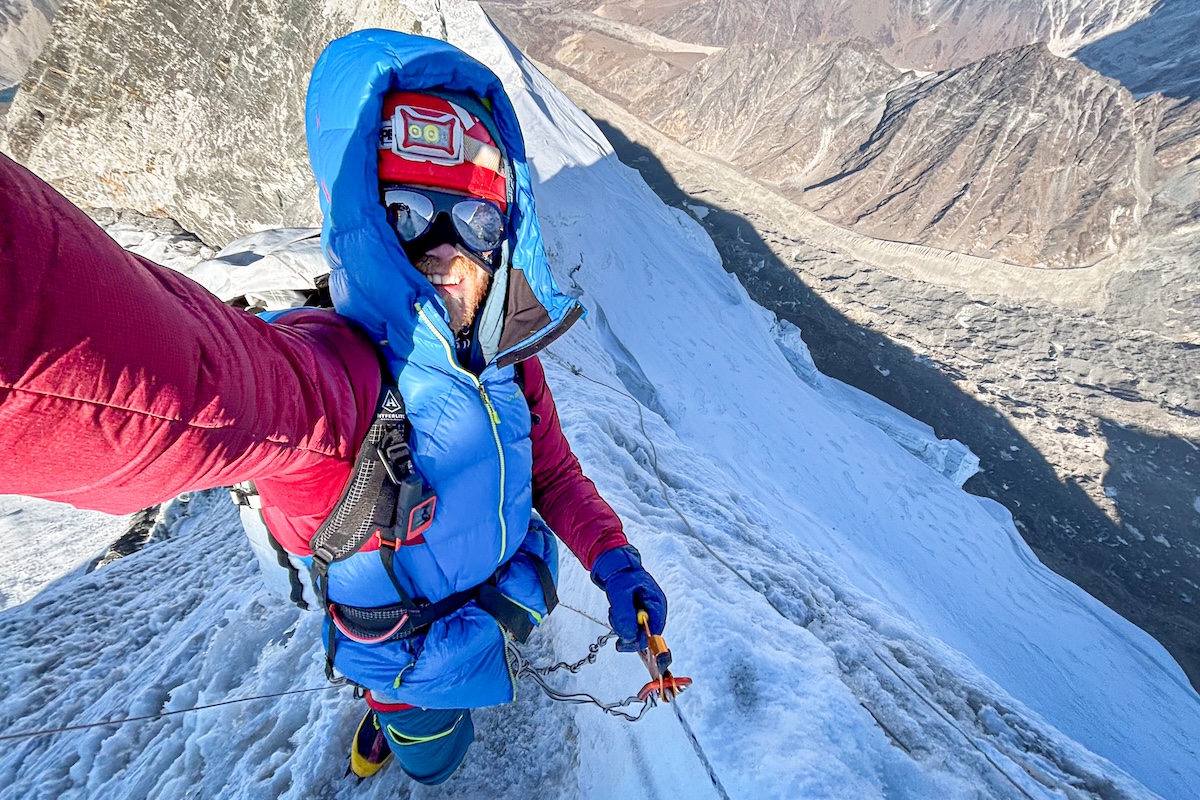
Double boots are built for cold weather, multi-day expeditions, and climbing the world’s highest peaks—but they are often necessary for winter ascents in the lower-altitude ranges in the United States. They often are significantly heavier than single boots and less sensitive overall, but some models like the Scarpa Phantom 6000 HD and La Sportiva G2 Evo offer a nice combination of the two (reasonably lightweight boots with technical features). For the tallest peaks and coldest climates—think places like the high Himalaya, Antarctica, and Denali—look toward the top of each brand’s collection. The La Sportiva Olympus Mons and Scarpa Phantom 8000 Thermic, for example, are built specifically for these types of places.

Boot selection is not always a cut-and-dry choice and depends as much on your objective and style of ascent as it does on conditions. Weather and temperature also play a role in determining boot type, and the season you choose to climb in may call for a warmer or lighter boot. For example, during an austral summer in Patagonia, one of our testers attempted Cerro Torre in single boots but found they weren’t adequate for the icy flanks of that impressive tower. They were, however, completely sufficient on his ascent of the nearby Fitz Roy a few weeks later (different aspect, different weather, moderate rock climbing vs. ice climbing) and offered more of the streamlined build and rock prowess that he needed. If it’s a toss-up, we do recommend erring on the side of warmth, and the good news is that many modern boots offer great insulation alongside performance.
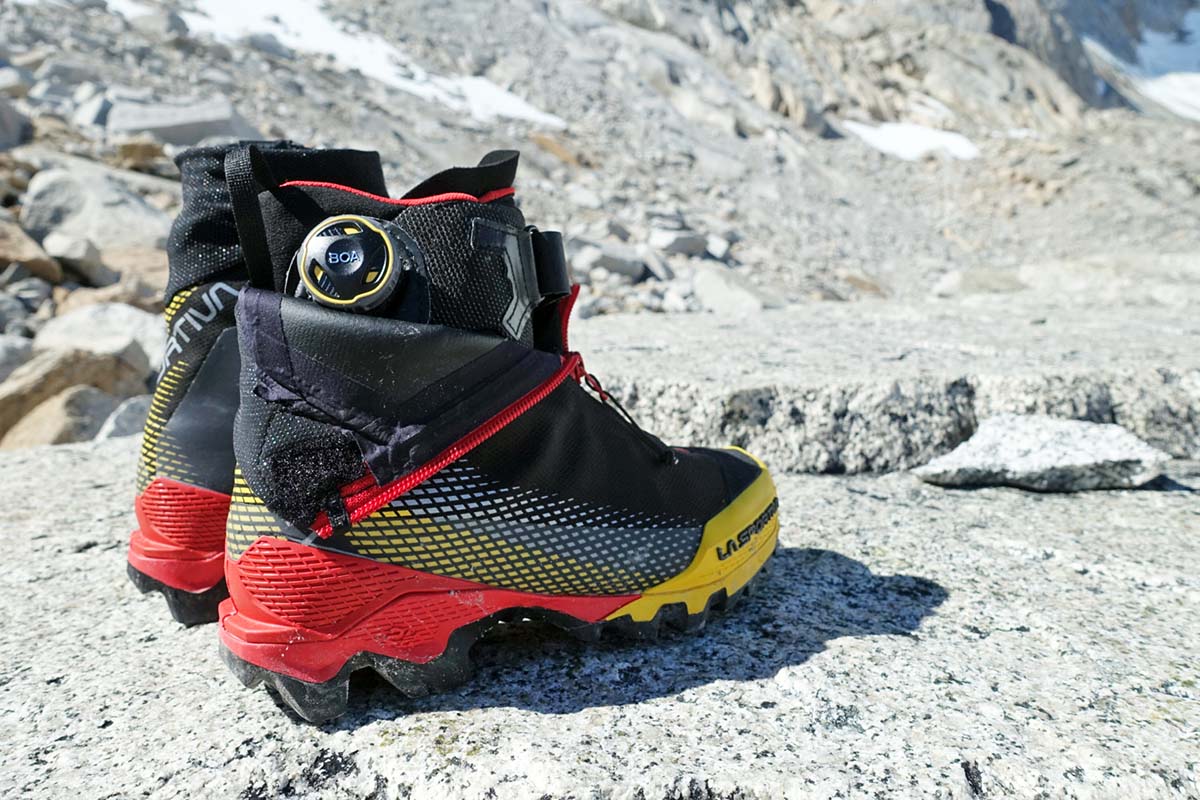
The shell is your first line of defense against the harsh conditions of a mountain environment. It needs to be durable (able to stand up to abrasion from rocks, crampons, and skis) and also must keep out snow, water, and mountain grit. In addition, much of a boot’s stiffness comes from the shell, which is important when it’s time to ice climb or do a little survival skiing on the way down. The vast majority of boot shells are now entirely synthetic or a combination of synthetics and leather.
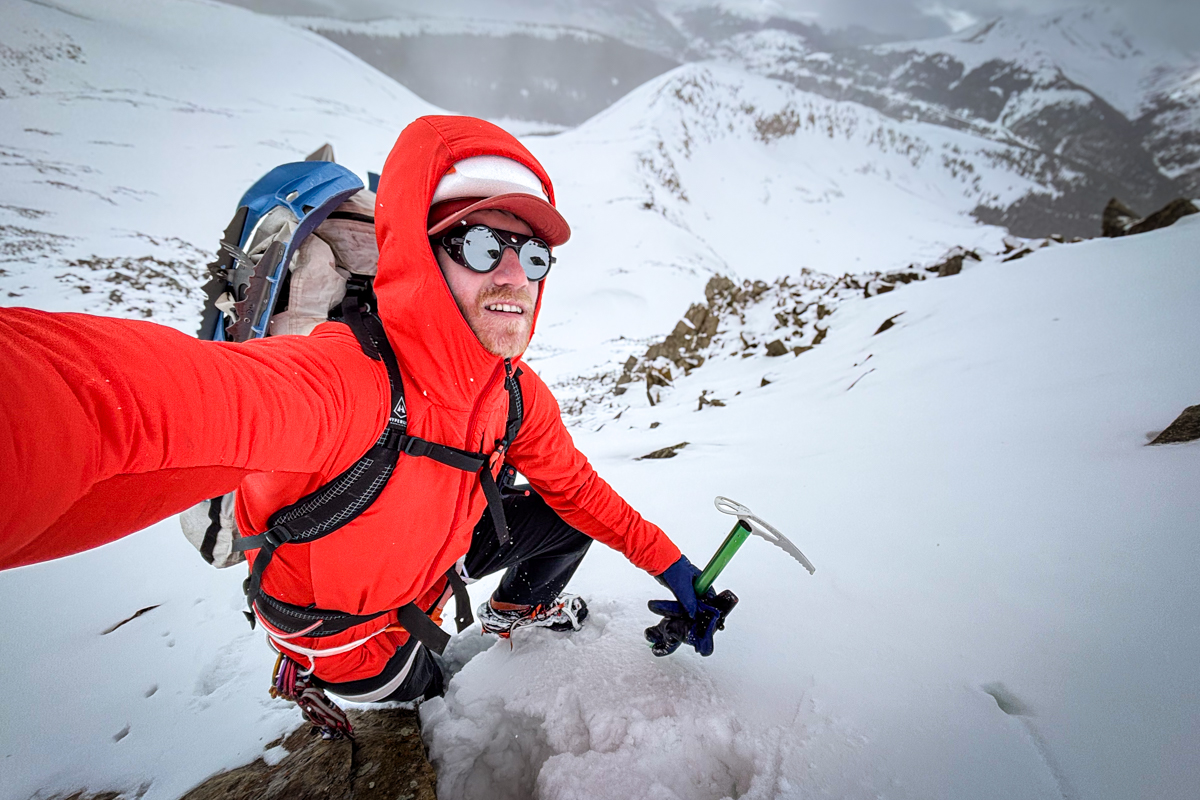
Many climbers prefer modern synthetic boots, namely because they weigh less, offer more precision with less bulk, and don’t stretch out of shape like leather. However, the downside comes in the form of durability—almost without exception, leather boots will last longer. For example, our synthetic La Sportiva Trango Tech GTX (not featured above) took a beating during a two-week traverse in the Alaska Range, whereas a leather model might have just started to feel broken in. If you do opt for a leather boot (such as the La Sportiva Nepal Cube GTX or Scarpa Mont Blanc Pro GTX), we recommend adding an aftermarket snow and water seal to keep moisture from soaking through and weighing you down.

A decade ago, plastic boots were a popular way to go. Compared to soft leather or synthetics, plastic feels more clunky and less precise when technical footwork is needed. But it does have its benefits: not only is plastic significantly cheaper, it’s also much more durable. If you are an occasional mountaineer on a budget or only intend to climb a few mountains, plastic may be a good option. Adding an Intuition Denali liner will make them warmer while dropping almost a pound of weight in the process. For big mountains like Denali, a Forty Below Purple Haze overboot ($220) will be necessary as well, which may require that you purchase a different crampon to fit over the boot. In 2025, however, you will see very few plastic boots, and the leather and synthetic alternatives are far superior. Further, if you customize your plastic boot as described above, it will end up costing over $800, which isn't much less than the price of a high-end synthetic double boot of equal warmth and superior technical precision.

Big mountains require big boots, often with a big price tag. Some of the extreme cold/high-altitude models on the list, like the Scarpa Phantom 8000 Thermic, are over 6 pounds for the pair and take up a decent chunk of your duffel bag. On the other end of the spectrum, you can go with a lightweight single boot like the La Sportiva Aequilibrium ST GTX for just 2 pounds 12.4 ounces total. To be sure, it’s harder to move fast with more weight, but serious mountaineering typically does not involve highly technical climbing for extended stretches. It’s more steep walking and basic ice/rock moves, so shaving ounces is not as important as warmth. If your aim is technical climbing—pitch after pitch of near vertical climbing—size and weight will likely be a deciding factor in your boot purchase.

The good news is that high-end mountaineering boots have cut excessive frills and, although still heavy and bulky, are lighter than even a decade ago. A few ounces or grams may not seem like a big deal, but imagine post-holing through steep snow for 20,000 steps. To quantify this comparison, a 1-ounce difference in boot weight means that each leg will lift an additional 1,250 pounds during that time. The adage that “ounces make pounds and pounds are heavy” is especially true regarding your feet. Additionally, many climbs demand long approaches at lower elevations, requiring you to carry your technical mountaineering boots on a backpacking or climbing pack for miles or days. It's important to ensure you have space in your pack, or straps on the outside, to accommodate whatever boots you end up purchasing. One of our editors recently had to haul the La Sportiva G2 Evos over 80 miles round trip to access remote climbs in the Khumbu region of Nepal—and was thankful for every gram Sportiva was able to shave off.

Cold feet can mean the difference between sending or going home early, so finding a boot that will keep you warm in the coldest conditions you’ll encounter is key. Double boots like the La Sportiva Olympus Mons Cube and Scarpa Phantom 8000 Thermic are the warmest models on the market, with features like thickly insulated inner boots and thermo-reflective liners on the outer boot. The Phantom Thermics even go the extra mile by adding a removable heated footbed with a power bank and external power switch—truly futuristic technology for the most extreme conditions on the planet. On the other hand, single boots run the gamut from insulated designs like Scarpa’s Phantom Tech or Lowa’s Alpine Expert GTX to stripped-down builds that forgo insulation, such as the La Sportiva Aequilibrium and Trango Tech. Keep in mind that warmth usually comes at a cost—a more insulated boot will be heavier, less precise, and suffer in terms of breathability—and you’ll want to be sure to find the right balance for your particular objectives.

When looking at a single boot’s warmth, one of the main specs to pay attention to is the lining, which will either be insulated or non-insulated. For summer objectives that involve a mix of trail, rock, and snow or ice, we recommend opting for a non-insulated design, as the added warmth will be overkill (especially on the approach) and you likely won’t want to carry the extra weight either. Alternatively, insulated single boots are great for all-season use and snowy summer objectives (like Mt. Rainier, for example), when temperatures are below freezing or your feet might not see dry land all day. And in the end, if you plan on doing a wide range of climbing from winter or high-altitude ascents to technical summer scrambling, you’ll ultimately want to invest in at least two pairs of boots.

Depending on the double boot (remember that single boots don’t have removable liners), liners may provide a significant portion of a boot’s warmth and support. This is the part of the boot that you will want to remove at night during a multi-day trip, and the ability to dry the liner by stuffing it into your jacket or sleeping bag is imperative. Heavy, thick liners made of water-absorbing materials will not dry completely throughout an alpine evening, which is why most modern boot liners are constructed of hydrophobic materials like closed-cell foam. Single boots, on the other hand, feature a built-in liner, which often is made up of a waterproof membrane and a layer of insulation (as we learned in the “warmth” section above, some single boots do not have insulation). Because these liners can’t be removed, they feature thin constructions that wick moisture, whether your boot is on or off your foot.
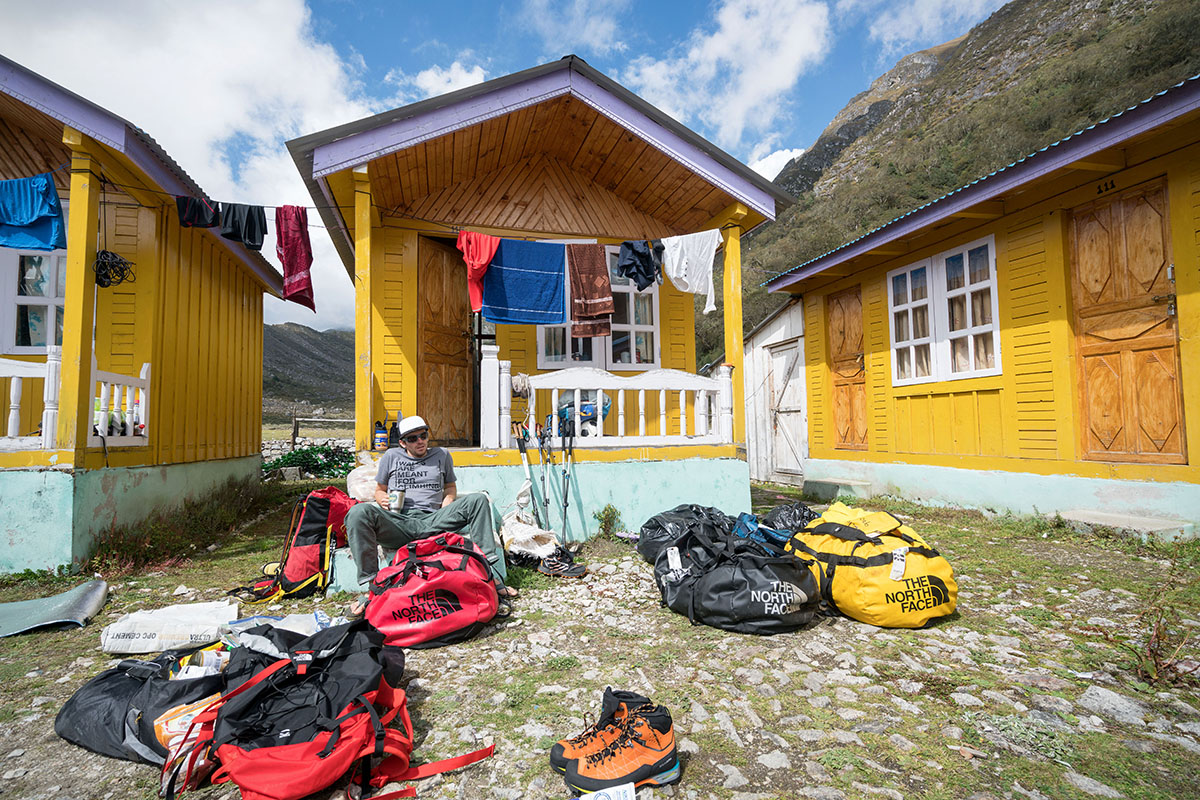
In some ways, mountaineering boots need to do their best impersonation of a “quiver of one” type of footwear. In addition to the warmth and protection they provide, they need to be part rock climbing shoe, part hiking boot, and even maybe an occasional ski boot. Having the ability to tighten the boot down when ice climbing or skiing and then loosen it when hiking is essential. Mountaineering boots don’t have lockdown modes like backcountry ski boots, but many now feature an upper and lower lacing system to isolate tightness to specific parts of the boot (like the La Sportiva Oly Mons Cube or G2 Evos pictured below).

Sole stiffness, or stiffness underfoot, is also an important factor to consider—different types of climbing require varying sole stiffness. For low-altitude mountaineering, where you won’t be doing technical ice climbing, you may want a boot with a ¾-shank sole (one that has some flex). These boots will feel like a stiff hiking boot and are better suited for long approaches, technical scrambling, or lower fifth-class rock climbing (like the Cascades’ classic Torment-Forbidden Traverse, for example). On the other side of the spectrum, full shank soles (with no flex) are optimal for technical ice climbing and advanced mountaineering with a step-in/automatic crampon.

Tightening your boots down doesn’t just involve basic laces anymore. Modern boots have a wide array of tightening systems, including standard tie laces, pull-down cinch laces, or even the high-tech Boa lacing system. Many companies have moved away from standard laces because they are hard to tie and untie in extreme weather. In addition, having the ability to easily tighten or loosen your boots (maybe with only one hand) while wearing thick gloves or mittens is critical. Lacing systems should be simple but efficient. The Boa system probably is the easiest to use, but it may be the most susceptible to breaking in an alpine environment (because of this, we love that Sportiva integrated dual Boa closures into their Oly Mons Cube—when one goes, your entire boot functionality doesn’t go with it). Luckily, Boa sells repair kits for very cheap, and they can be reinstalled in about the same amount of time as it would take to replace a shoelace.

Automatic (Step-In) Crampons
For each boot, we’ve specified whether or not it is compatible with an automatic crampon. An automatic crampon—also known as a step-in crampon—uses a wire toe bail and heel clip to provide the most secure attachment, ideal for ice climbing or technical mountaineering (the Petzl Dart, for example). If we’re climbing anything that is remotely approaching vertical, we want an automatic crampon. In order to be compatible with this style of crampon, a boot must have toe and heel welts and a fairly stiff build that provides a stable structure for the crampon. Every double boot on this list is compatible with an automatic crampon.
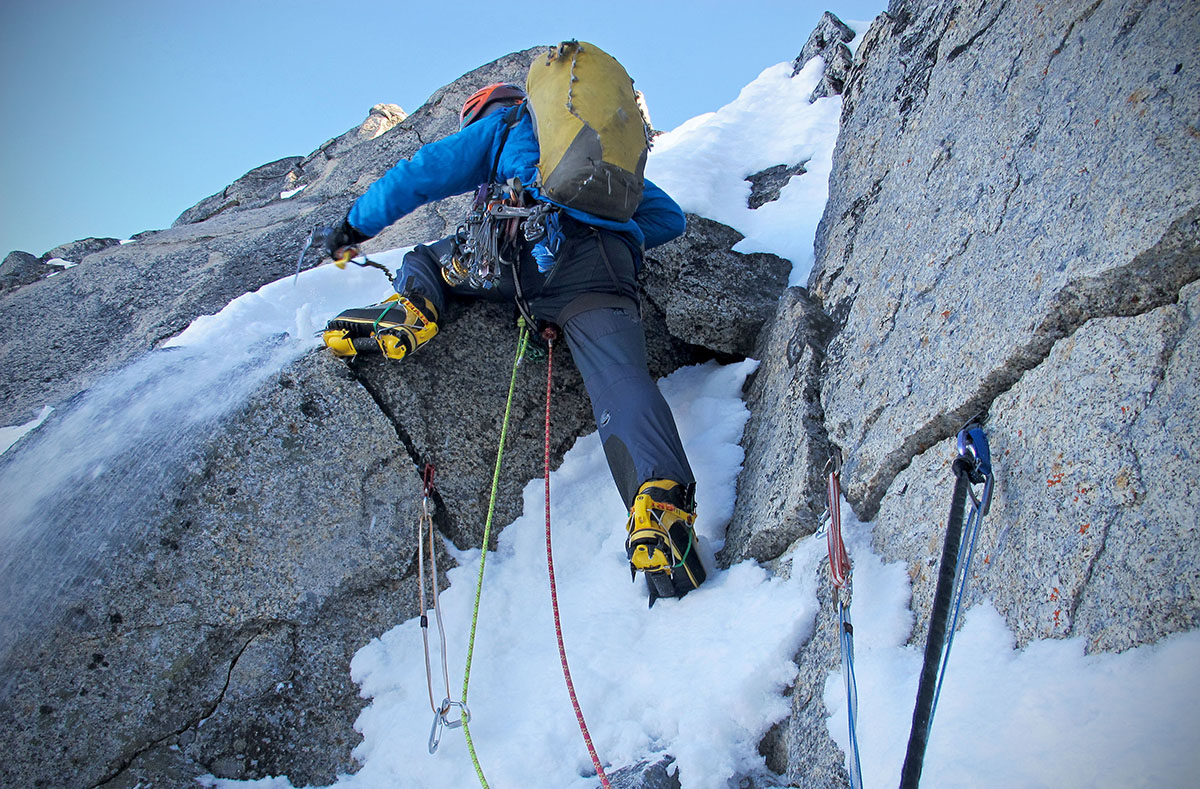
Semi-Automatic (Hybrid) Crampons
More flexible, streamlined single boots often forgo the toe welt and otherwise shave weight by having a thinner last. The majority of these models—such as the La Sportiva Aequilibrium ST GTX—still have a heel welt, which is essential for compatibility with a semi-automatic crampon (also known as a hybrid crampon). A semi-automatic crampon combines the front plastic loop of a strap-on crampon (see below) and the heel clip of a step-in crampon. While less secure than a step-in crampon, semi-automatic crampons are a far better choice for lightweight or flexible boots because they have more ability to move with the boot.
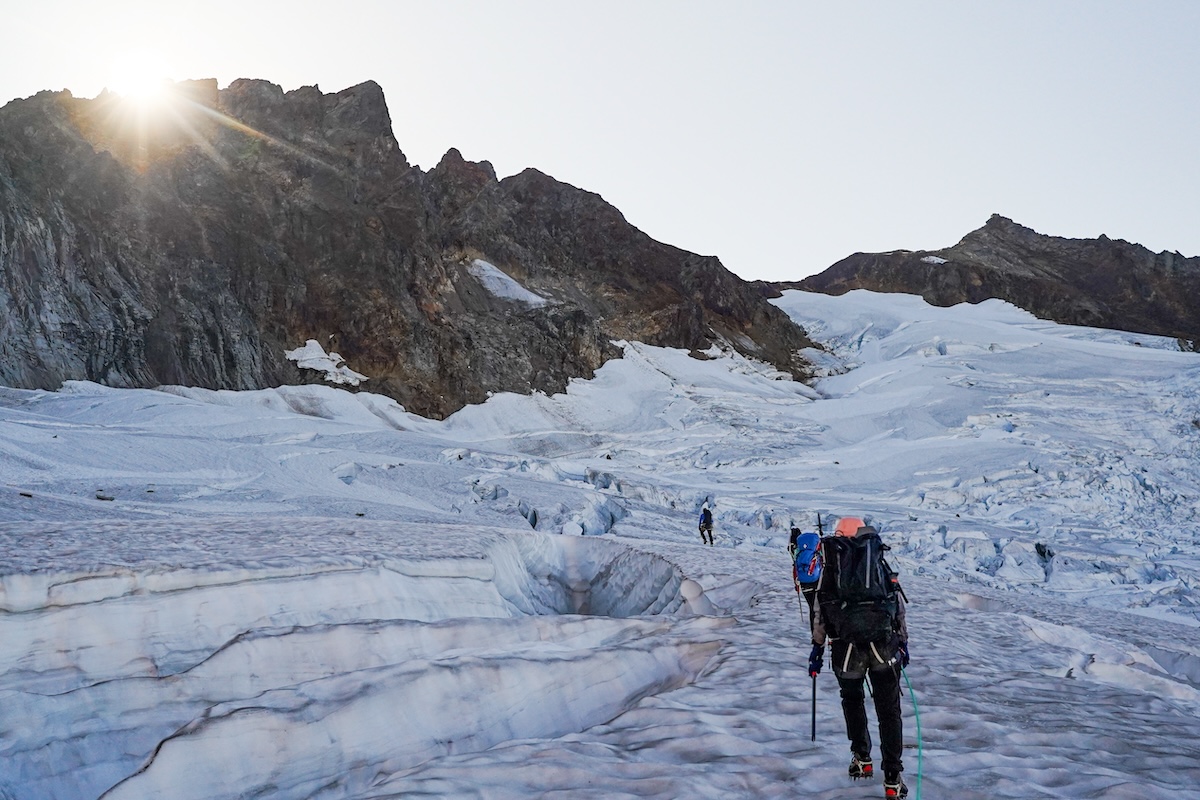
Strap-On Crampons
The last type of crampon is a full strap-on crampon (plastic loops in front and back with webbing to tighten). Strap-on crampons are highly adaptable, and even are capable of fitting on approach shoes or trail runners (our favorite lightweight design is the Petzl Leopard FL). They do have limited technical performance, however, as they do not secure as tightly to the boot as a step-in or semi-automatic crampon. Strap-on crampons can be attached to any sort of boot, although they would have very compromised functionality when paired with a stiff build, and are not appropriate for ice climbing or technical mountaineering. The lesson here is: Make sure your boot can accommodate the type of crampon you need, and don’t forget to check compatibility and fit before any big trip.
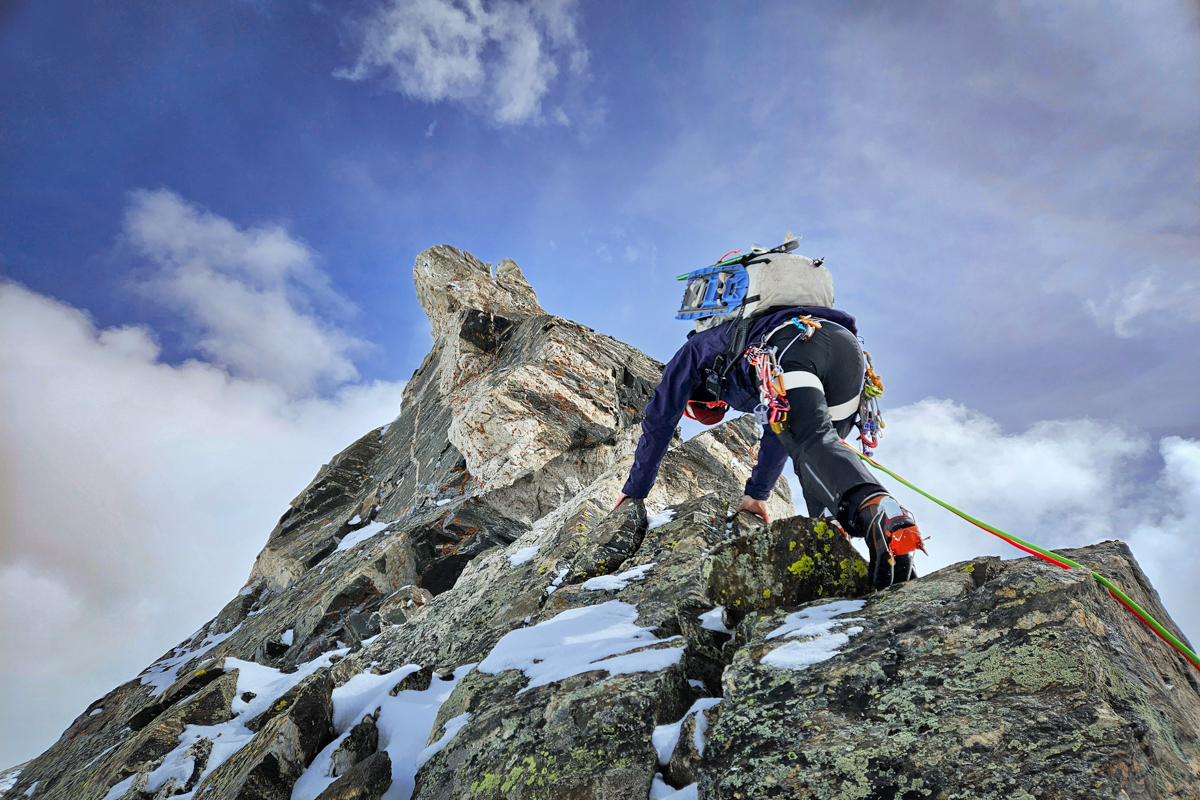
If you ever plan on climbing a mountain like Denali, where you may use your mountaineering boots with skis (utilizing bindings such as the Silvretta 500), it’s essential that your boot has both a heel and toe welt. These are the same flat rails on the front and back of the boot that serve as the connection point for automatic crampons (see above). Bindings like the Silvretta aren’t made for aggressive skiing, but they do allow you to use skis (skinning tends to be faster than snowshoeing) without needing to bring along your ski boots. And now, mountaineers approaching on skis have a whole new option in the La Sportiva Olympus Mons Cube, which features tech fittings at the toe for compatibility with pin bindings (standard on most backcountry skis).

Different companies use different lasts for their mountaineering boots. Some tend to be slightly narrower (La Sportiva and Arc’teryx) while others routinely have a slightly boxier feel (Scarpa). Just because you wear a size 44.5 street shoe doesn’t mean that it will translate directly into a big mountaineering boot. You may be a 44.5 in La Sportiva, a 44 in Scarpa, and a 45 with a thick insole in Arc’teryx, for example. And every boot has a unique fit, and it can take some work to dial it in. Always try on your boots well before a trip—a little extra heel room quickly can develop into a show-stopping blister that keeps you from reaching the summit. Or a tight toe box can restrict blood flow and lead to frostbite. Your feet swell as you stand on them, so we recommend trying boots on in the afternoon after you have been walking around for a few hours.

Mountaineering involves long days (often back-to-back for a week or more) of carrying heavy packs and using your feet in dynamic ways. Accordingly, an insole is the first line of support in your boot. Custom boot fitters will say, “If you buy a $1,000 boot, throw away the $0.10 insole.” Often, that is true, although companies like La Sportiva and Scarpa seem to have taken note. Many of their boots now come with quality insoles that not only offer support and comfort, but a bit of additional warmth as well. A good insole should support your foot, both in terms of supporting your arch and cupping your heel.
If the included insole doesn’t work for you, consider spending another $40 to 50 for a heat-molded insole from a reputable brand like Sole or Superfeet. Aside from providing additional warmth, these insoles come in a variety of thicknesses that can take up space if there is a little too much room (or even work out tight spots). And when making a boot purchase, it’s always better to go slightly bigger as opposed to going too tight—it’s easier to take up room than to make it.
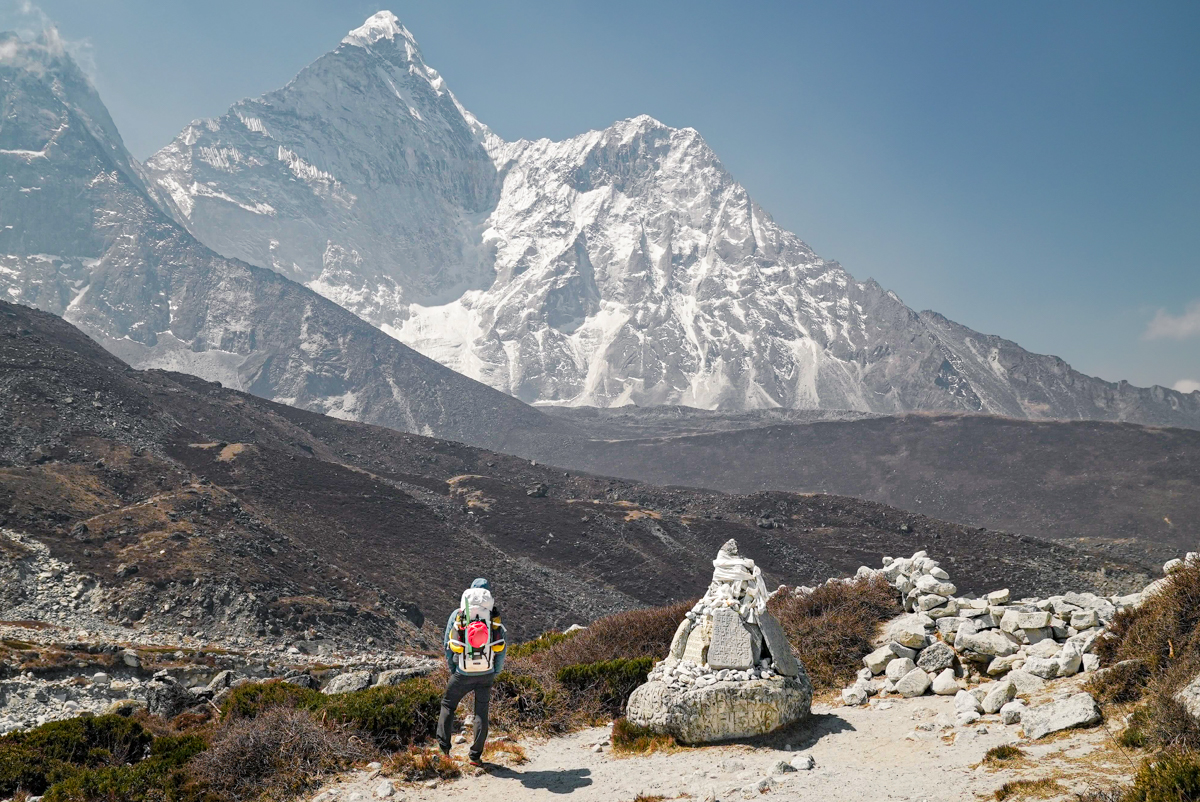
As with other types of climbing footwear, the most important thing in choosing a mountaineering boot is fit. Most of the models listed above technically are unisex, while a few, like the La Sportiva Nepal Cube GTX, Scarpa Charmoz, and Scarpa Mont Blanc Pro GTX, also come in women’s-specific versions. It’s extremely common for women to wear unisex boots—again, it’s all about fit, and only a handful of models are even available in women’s versions. It’s also worth noting that La Sportiva and Arc’teryx tend to run narrow, which—at least in theory—should be more akin to the shape of a women’s-specific design.

There’s an old adage in the outdoor gear world: “Between light, durable, and cheap, you can pick two of the three.” Over the last decade or so, mountaineering boots have seen a tremendous jump in precision and technical design while also cutting some weight. Unfortunately, this has come at the expense of durability to some extent. Plastic boots were almost indestructible, but at the same time, they could feel rather clunky. Leather boots are heavy and can get even more weighed down when wet, but they’re also built to last. And then there are new-age synthetic boots like the Scarpa Phantom series, which manage to be warm, lightweight, and technical climbing machines. This is attained by using ultralight polyurethanes, foam, and synthetic fabrics, but these materials are much less durable than the plastic and leather boots of old.

For most modern climbers, the tradeoff is well worth it. One of our Alaska testers has found that his high-altitude double boots last him about three years (he averages 60 days of abusive use per season), and the average mountaineer will get many more years of use out of their boots. Further, chances are that when you have them on your feet, you’ll be thinking much more about the greater flexibility, technical prowess, and lower weight than mulling over how long they’ll last. Of course, there is a balance, and we’ve found that some of today’s most stripped-down designs (like the Aequilibrium ST GTX) go a little too far for most uses. The good news is that for those who prize durability above all else, there are always trusted workhorses like the leather Nepal Evo or plastic Scarpa Inverno.
Back to Our Mountaineering Boot Picks Back to Our Boot Comparison Table